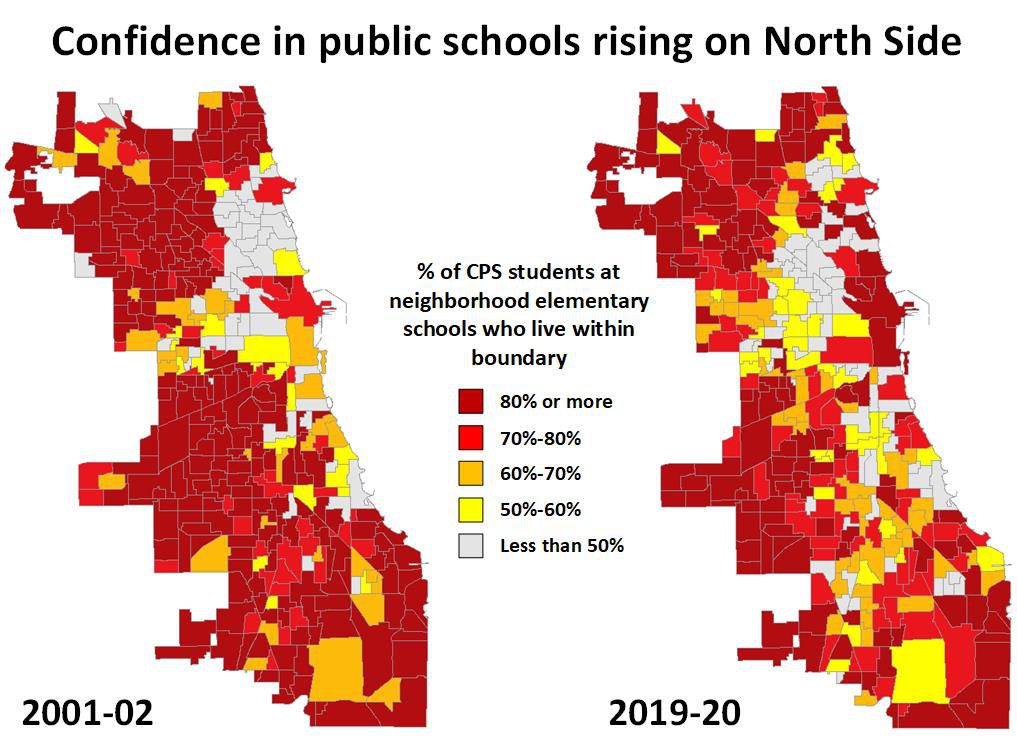
On the North Side, Chicago public elementary colleges are an more and more common selection for middle-class households.
On the West Side and South Side, although, mother and father are abandoning neighborhood colleges. At dozens of faculties, principally in African American communities, enrollment has dropped so low that closing or consolidation appears inevitable.
Those are the takeaways from an evaluation of CPS information displaying a college system within the midst of profound change.
There’s motive for optimism. Thirty years in the past, few middle-class mother and father in Chicago willingly despatched youngsters to the neighborhood public college. Now, many do — a unprecedented turnaround for a college system as soon as derided because the worst within the nation.

Elsewhere within the metropolis, although, neighborhood colleges are in unmistakable decline.
The accompanying maps, based mostly on practically 20 years of knowledge, present the modifications remodeling the Chicago Public Schools. The maps mirror mother and father’ confidence in a specific college as demonstrated by whether or not they ship their youngsters there.
The first set compares the share of scholars at neighborhood CPS colleges who stay inside their college’s attendance boundary for the 2001-02 college yr vs. 2019-20.
 Ed Zotti / Sun-Times
Ed Zotti / Sun-Times
In 2001-02, CPS college students in most elements of town attended their neighborhood college.
The main exception was the north lakefront. At most public colleges on this prosperous space, fewer than half of the scholars lived within the neighborhood. The relaxation usually had been minorities transferring from different elements of town.
Clearly, many middle-class households alongside the north lakefront on the time despatched their youngsters to non-public colleges.
The state of affairs is completely different as we speak. At many neighborhood colleges on the north lakefront, most college students stay close by. At some, enrollment is way larger. Blaine School in Wrigleyville had 568 college students in 2001-02 and has 815 now. Ogden School on the Near North Side went from 560 to 1,111.
How many youngsters in these neighborhoods attend non-public colleges isn’t identified. It’s truthful to say a rising share of them, many from middle-class households, are going to CPS.
Some neighborhood college advocates say the impetus for this has been grassroots organizing, usually within the type of a “Friends of [local] School” group. An on-line search turns up greater than 50 such teams dedicated to CPS colleges.
A standard begin for “Friends of…” teams is moms taking their toddlers to a park and commiserating over the price of non-public colleges, then banding collectively to help the neighborhood college.
If the principal is prepared, they volunteer, maintain fundraisers and different occasions and provides excursions.
Gradually, they persuade extra households to ship their youngsters to the college. An indication {that a} college has turned the nook in mother and father’ eyes is when actual property brokers begin promoting “in [local] school district” in dwelling listings.
“In the case of lakefront neighborhoods, it’s safe to say every single neighborhood school that changed to majority local attendance saw the formation of a ‘Friends of…’ group sometime in the last 20 years,” one college activist says.
Crediting “Friends of…” teams as mainly answerable for the change in North Side colleges is “a leap,” says Elaine Allensworth, director of the UChicago Consortium on School Research.
Among components that Steve Tozer, founding father of the Center for Urban Education Leadership on the University of Illinois at Chicago, cites are these:
Better colleges total. “CPS is in the top 5% of the country in terms of school improvement,” Tozer says. Better principals. “Chicago has become nationally recognized for school leadership development,” hiring 300 principals up to now 20 years educated by applications like UIC’s. Local college councils — the elected boards at every CPS college. “LSCs give mother and father leverage to have affect as a result of they’ll rent and hearth the…
Source hyperlink